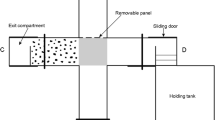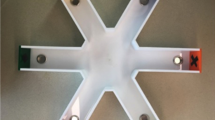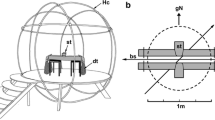Summary
Allegheny wood rats (Neotoma floridana magister) are occasionally found beyond the light penetration zone in caves. The means of orientation used by cave-trapped rats were studied using a radial maze and double-platform jumping tasks. The effects of various sensory manipulations upon their performances were evaluated, including visual deprivation, reversible deafening, control of chemical cues, and vibrissae trimming. The rats performed best when visible light was available, but they were able to do the tasks in the absence of light as long as their hearing was intact. Manipulation of other sensory cues had no effect. Intact animals seldom produced sounds when ambient sounds were available, but when these were very soft they did produce nonvical sounds. It appears that these cave-dwelling wood rats use acoustic means of orientation in the dark and that they are able to use some environmental sounds when these are available.
Similar content being viewed by others
References
Awdykovych, M., Chase, J.: Echolocation in rats? Paper presented at annual meeting of Am. Anim. Behav. Soc., Boulder, Colorado, 1976
Birney, E.C.: An assessment of relationships and effects of interbreeding among woodrats of the Neotoma floridana speciesgroup. J. Mammal. 57, 103–132 (1976)
Cranford, J.A.: Home range and habitat utilization by Neotoma fuscipes as determined by radiotelemetry. J. Mammal. 58, 165–172 (1977)
De l'Aune, W., Bauer, S.: Audiometric predictor of acoustic environmental assessment performance in blinded veterans. I. Methodology and instrumentation. IRCS Med. Sci. 3, 406 (1975)
De l'Aune, W., Scheel, P., Needham, W., Kevorkian, G.: Evaluation of a methodology for training indoor acousitc environmental analysis in blinded veterans. Proc. Conf. Eng. Devices Rehabilitation 1974
Gould, E., Negus, N.C., Novick, A.: Evidence for echolocation in shrews. J. Exp. Zool. 156, 19–38 (1964)
Gourevitch, G.: Detectability of tones in quiet and noise by rats and monkeys. In: Animal psychophysics, Chap. 4. Stebbins, W.C. (ed.). New York: Appleton-Century-Crofts 1970
Griffin, D.R.: Acoustic orientation in the oilbird, Steatornis. Proc. Natl. Acad. Sci. 39, 884–893 (1954)
Griffin, D.R.: Listening in the dark. New Haven: Yale University 1958
Griffin, D.R.: The physiology and geophysics of bird navigation. Q. Rev. Biol. 44, 255–276 (1969)
Honzig, C.H.: The sensory basis of maze learning in rats. Comp. Psychol. Monogr. 13, 1–113 (1936)
Howell, A.B.: Anatomy of the wood rat. Baltimore: Williams & Wilkins 1926
Kahmann, H., Ostermann, K.: Wahrnehmen und Hervorbringen hoher Töne bei kleinen Säugetieren. Experientia 7, 268–269 (1951)
Keller, H.: The story of my life. New York: Doubleday, Page & Co 1903
Kinsey, K.P.: Social behaviour in confined populations of the Allegheny woodrat, Neotoma floridana magister. Anim. Behav. 24, 181–187 (1976)
Kinsey, K.P.: Agonistic behavior and social organization in a reproductive population of Allegheny woodrats. J. Mammal. 58, 417–419 (1977)
Linsenmair, K.E.: Anemomenotactic orientation in beetles and scorpions. In: Animal orientation and navigation. Galler, S.R., Schmidt-Koenig, K., Jacobs, J, Belleville, R.E. (eds.). Washington: NASA 1972
McCue, J.J., Bertolini, G.: A portable receiver for ultrasonic waves in air. IEEE Trans. Sonics Ultrason. Groups Su-11, 41–49 (1964)
Novick, A.: Acoustic orientation in the cave swiftlet. Biol. Bull. 117, 497–503 (1959)
Novick, A.: Acoustic orientation. In: Biology of bats, Vol. III, Chap. 2. Wimsatt, W.A. (ed.). New York: Academic 1977
Plummer, W.T.: Infrasonic resonances in natural underground cavities. J. Acoust. Soc. Am. 46, 1074–1080 (1969)
Walls, G.L.: The vertebrate eye, Vol. 19. Bloomfield Hills, Mich.: Cranbrook. Institute of Sciences Bulletins 1942
Wilson, J.P.: Psychoacoustics of obstacle detection using ambient or self-generated noise. In: Animal sonar systems. Busnel, R.-G. (ed.), pp. 89–114. Jouey-en-Josas, France: Laboratoire de Physiologie Acoustique 1967
Yodlowski, M.L., Kreithen, M.L., Keeton, W.T.: Detection of atmospheric infrasound by homing pigeons. Nature 265, 725–726 (1977)
Author information
Authors and Affiliations
Rights and permissions
About this article
Cite this article
Dunning, D.C., Payne, L.N. Orientation in Cave-Dwelling wood rats. Behav Ecol Sociobiol 6, 1–9 (1979). https://doi.org/10.1007/BF00293239
Received:
Accepted:
Issue Date:
DOI: https://doi.org/10.1007/BF00293239




